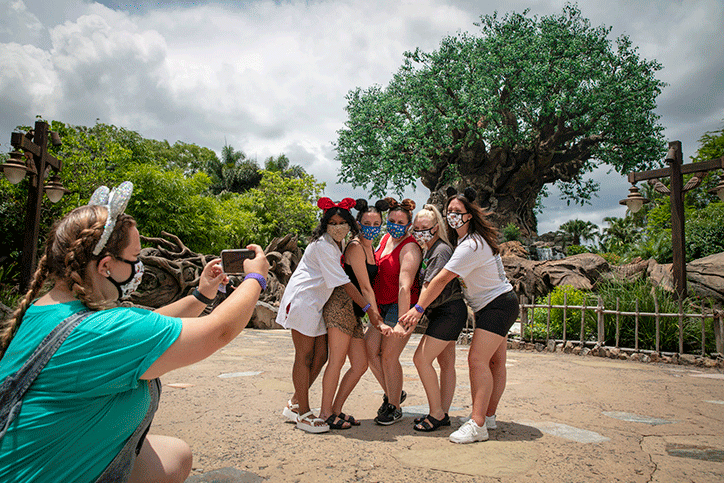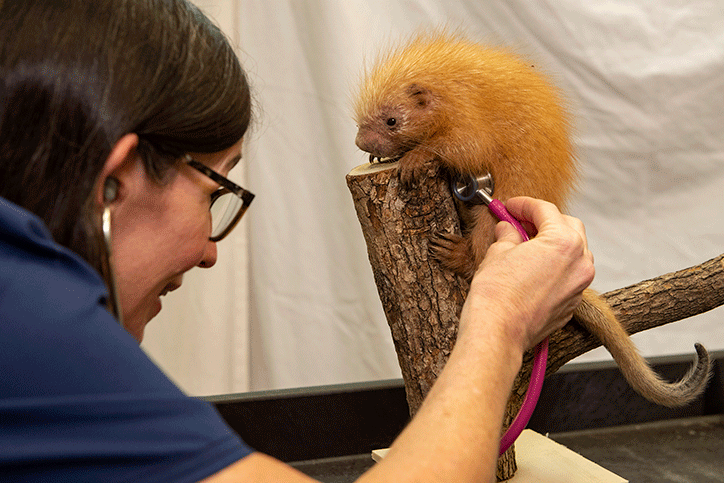Shh...These Disney Animal Kingdom Secrets Can Make Your Theme Park Trip So Easy

With the park reopened on July 11, there’s no better time to celebrate Disney’s wild side!
by Lisa A. Beach
When Disney’s Animal Kingdom opened on Apr. 22, 1998, it coincided with Earth Day that year. That’s no surprise, really, as Animal Kingdom is dedicated to animal conservation and the environment in a space that’s part theme park, part zoo. While Disney temporarily shuttered all four of its Orlando theme parks during the pandemic back in March, Animal Kingdom and Magic Kingdom just reopened on July 11, 2020. This marks a perfect time to dig into Animal Kingdom’s 22-year history as Walt Disney World’s fourth — and largest — theme park.
 On March 21, 2020, the animal care team at Disney’s Animal Kingdom at Walt Disney World Resort in Lake Buena Vista, Fla., welcomed a new female Hartmann’s mountain zebra foal to the herd. The 65-pound zebra was born to mom Heidi and was up and moving just a few minutes following her birth. (Disney)
On March 21, 2020, the animal care team at Disney’s Animal Kingdom at Walt Disney World Resort in Lake Buena Vista, Fla., welcomed a new female Hartmann’s mountain zebra foal to the herd. The 65-pound zebra was born to mom Heidi and was up and moving just a few minutes following her birth. (Disney)
14 Things You Might Not Know About Disney’s Animal Kingdom
- You may know the basics: The 500-acre park is home to 2,000 animals representing 300 species from around the world, including giraffes, hippos and Komodo dragons. However, surprisingly, about 8,000 additional animals live throughout other parts of Walt Disney World property, including Fort Wilderness, Animal Kingdom Lodge and Epcot’s Living Seas.
- To prepare for how they’d build the park, a core team of seven Walt Disney Imagineers crisscrossed the globe, researching the look and feel of life in the wild so they could replicate it back in Florida. The team traveled more than 500,000 miles — a distance equal to circling the globe 20 times.
- More than four million (3,000 species) trees, plants, shrubs, vines, grasses and ground-coverings — from every continent on Earth except Antarctica — dot the safari landscape to imitate the residents’ natural surroundings.
- The Tree of Life — which is not real — stands 145 feet tall and 160 feet wide, serving as the park’s centerpiece. A team of 10 artists and three Imagineers worked full-time for 1½ years to create the tree’s 325 animal carvings. Sculptors had to work fast — between six to 10 hours to create the finished image before the plaster hardened.
- More recently, a team of more than 60 artisans from the U.S., France, Ireland, Japan, Peru and Portugal helped create the art-scape of the floating mountains on Pandora — The World of Avatar.
- To help new arrivals smoothly transition into Animal Kingdom, the team often uses items that comfort the animals. When one rhino relocated to the park, he came with a bottle of cologne — his favorite scent — to make his journey more comfortable and calming. Let’s just say he was “obsessed” with the fragrance!
- The park’s animal nutrition team prepares more than 1,500 individual or group diets every day. They must consider the calories and dietary components required by a huge variety of animals, determining proper nutrition for animals ranging from eight-ton elephants to two-gram frogs. In total, the team delivers more than 10,000 pounds of food to the animals at Animal Kingdom and Animal Kingdom Lodge daily.
- The park’s nutrition center stocks a variety of herbs and spices, such as anise seed, ginger, garlic and parsley. They aren’t necessarily used to flavor the food but are used as “scent enrichment” for the animals. Some of the tigers, for example, love lemongrass. The animal care team plants lemongrass in the tigers’ habitat and they love to wipe it all over their bodies.
- Disney takes great pride in its conservation efforts. One success story: nearly 40 Guam kingfisher chicks have hatched at Animal Kingdom, significantly increasing the world population of these birds. Currently, only 145 of these birds exist in the entire world.
- If you’ve enjoyed the park’s Kilimanjaro Safaris, you know it’s a bumpy ride! Disney incorporated that rutted road into the landscape design on purpose to duplicate a remote African road. The behind-the-scenes magic of the Imagineering design team involved matching concrete with the surrounding soil, rolling tires through it, then tossing twigs, stones and dirt into it to mimic an authentic rough-road experience.
- The first birth at Animal Kingdom was a kudu, a large African antelope. One of the most recent births (in May 2020 during the pandemic) was also a first for the park: the birth of a babirusa piglet. Typically, the honor of naming these animals goes to the animal care team. They named the female piglet Kirana, which translates to “sunbeam” in Indonesian.
- Don’t be annoyed if you can’t get a plastic straw or cup lid at Animal Kingdom. Because these items pose risks to the health and safety of animals, Disney doesn’t allow them.
- Animal Kingdom boasts one of the leading zoo hospitals in North America, with an emphasis on advanced imaging, digital radiology, ultrasound and endoscopy. Plus, it’s one of only two animal hospitals in U.S. zoos with computed tomography (CT) scanners on the premises. This boosts the team’s ability to quickly diagnose and treat animals at the hospital.
- In April 2020, Disney’s Animal Kingdom theme park and Animal Kingdom Lodge hotel again received official accreditation by the Association of Zoos and Aquariums (AZA), which sets the gold standard for institutions that follow best practices for care of animals.
 Dr. Natalie MyIniczenko, a Disney veterinarian, checks vital signs of a baby female prehensile-tailed porcupine born Feb. 25, 2020, at Disney’s Animal Kingdom at Walt Disney World Resort in Lake Buena Vista, Fla. The baby porcupine is covered in a fine red fur coat with tiny quills underneath that begin to harden in the hours after birth. The baby is part of the Species Survival Plan (SSP) program overseen by the Association of Zoos and Aquariums (AZA) to ensure responsible breeding of threatened and endangered species. (David Roark, photographer)
Dr. Natalie MyIniczenko, a Disney veterinarian, checks vital signs of a baby female prehensile-tailed porcupine born Feb. 25, 2020, at Disney’s Animal Kingdom at Walt Disney World Resort in Lake Buena Vista, Fla. The baby porcupine is covered in a fine red fur coat with tiny quills underneath that begin to harden in the hours after birth. The baby is part of the Species Survival Plan (SSP) program overseen by the Association of Zoos and Aquariums (AZA) to ensure responsible breeding of threatened and endangered species. (David Roark, photographer)